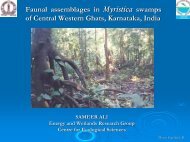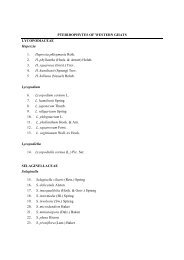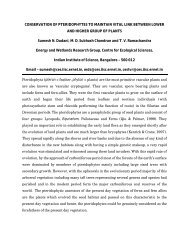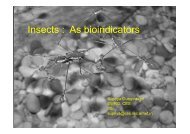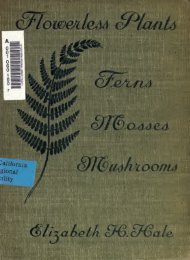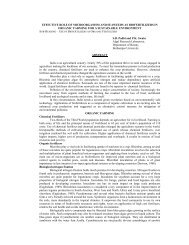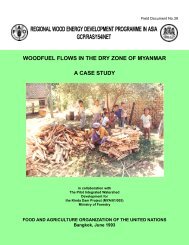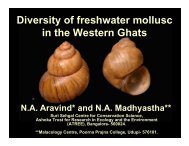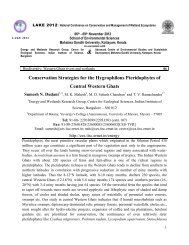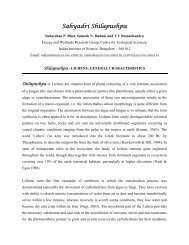a brief comp a brief comparison of modern pteridophyte arison of ...
a brief comp a brief comparison of modern pteridophyte arison of ...
a brief comp a brief comparison of modern pteridophyte arison of ...
Create successful ePaper yourself
Turn your PDF publications into a flip-book with our unique Google optimized e-Paper software.
C. R. Fraser-Jenkins : A Brief Comp<strong>arison</strong> <strong>of</strong> Modern Pteridophyte Classifications (Families and Genera in India) 109<br />
did not himself come to any conclusions or put forward any scheme <strong>of</strong> classification.<br />
RA RATION RA TION TIONALISING TION ALISING GENERA GENERA AND AND F FFAMILIES<br />
F AMILIES<br />
One <strong>of</strong> the signs <strong>of</strong> trouble with the mini-genera and families <strong>of</strong> the 1970s was that<br />
quite <strong>of</strong>ten no-one could recognise them. Many families in Pteridophytes were quite<br />
unusable, in <strong>comp</strong><strong>arison</strong> with those <strong>of</strong> Flowering Plants, and as circumscribed did not allow<br />
people to look at a fern and guess what family it belonged to. They could hardly be used in<br />
Floras because the reader could not find where to look for a species or genus if they were<br />
separated under the mass <strong>of</strong> close and unrecognisable families, and instead it was more useful<br />
to simply list the genera alphabetically and more-or-less ignore families. It is true that fernfamilies,<br />
even today, are perhaps not always as easy to recognise as in Flowering Plants as<br />
there are a number <strong>of</strong> exceptions due to soral migration along veins, exindusiate species etc.,<br />
but as the families were so split up in the 1970s the families then were totally impracticable<br />
almost to the point <strong>of</strong> meaninglessness. The editor <strong>of</strong> one as yet unpublished W. Asian Flora,<br />
for which the accounts <strong>of</strong> Pteridophyta were mostly written some 20 years ago, reacting to<br />
the situation that pertained following Pichi Sermolli and Ching, decided to abandon <strong>modern</strong><br />
fern-families altogether and place them all under Polypodiaceae, apparently not<br />
understanding how they had been rationalised in recent years.<br />
It was similarly difficult when it came to genera. While nearly everyone with a<br />
modicum <strong>of</strong> knowledge could recognise the major generic group ("polypodioid, thelypteroid,<br />
cheilanthoid, athyrioid" etc.), there were a number <strong>of</strong> split and closely affiliated, almost<br />
unrecognisable "genera" where, if they were candid about it, nearly all specialists would<br />
identify or recognise the species first and then know or look up which genus that species<br />
was in! The area par excellence where this was the case was in the thelypteroid genera <strong>of</strong><br />
Holttum (1971, 1982 etc.). Unlike what one less knowledgeable author in India said in<br />
adverse and misguided criticism <strong>of</strong> Holttum’s excellent and detailed work on<br />
Thelypteridaceae it was indeed most thoroughly and painstakingly based on genuine natural<br />
groups <strong>of</strong> species. With care these groups can be recognised even when the species is<br />
unknown. But what was inappropriate under today’s views was that the "genera" were so<br />
close morphologically, based on micro-characters such as hairs on the sporangium etc. It was<br />
a classic case <strong>of</strong> taxonomy according to the differences, while not giving enough weight to<br />
the evident close similarities. Holttum himself stated that in his opinion the only logical<br />
alternative to recognising them as genera would be to recognise a single genus, Thelypteris,<br />
which seems the most appropriate treatment to the present author, given their common<br />
features. In N. America (Smith & Cranfill 2002), and increasingly elsewhere as a result,<br />
Holttum’s genera (that concern India) have been grouped into 5 remodelled genera,<br />
Thelypteris (free veins [in India]), Cyclosorus (anastomosing veins [in India]), Phegopteris,<br />
Pseudophegopteris and Macrothelypteris. But it seems that this was very much a half-way<br />
house that should better have gone further. The present author recognises a single genus,



